|
|
|
|
|
Oil On
Canvas, Real Flavor of Old Masters
|
|

|
ARTWORKS
INDEX
A B C D E F G H I J K L M N O P Q R S T U V W X Y Z |
ARTISTS
INDEX
A B C D E F G H I J K L M N O P Q R S T U V W X Y Z |
|
|
| | |
|
|
 |
ZUCCARO Taddeo -- Click Here
|
|
Italian Mannerist Painter, 1529-1566
Painter and draughtsman. Taught to draw by his father, at the age of 14 he went alone to Rome where, according to Vasari, he was employed in various workshops and studied independently, particularly the works of Raphael. Through assisting Daniele de Porri (1500-77), who had trained in Parma, he learnt of the work of Correggio and Parmigianino. He first became known for his paintings on fa?ades, notably scenes from the Story of Furius Camillus on the palazzo of a Roman nobleman Jacopo Matteo, executed in 1548. Vasari claimed that Taddeo's fa?ade decorations equalled those of Polidoro da Caravaggio; none survives, although some are documented in drawings (e.g. London, BM; Paris, Louvre) and show his assimilation of Polidoro's style. Taddeo's earliest extant works date from 1553 when he collaborated with Prospero Fontana on the decoration (part destr.) of the villa of Pope Julius III outside the Porta del Popolo in Rome; Taddeo's contributions included scenes of The Seasons in the loggia of the nymphaeum. In these, clarity of form and space, natural proportions and idealization of human form demonstrate his affinity with the classicism of the High Renaissance. He also assimilated the sculptural sensibility of Mannerism, derived from Michelangelo. |
|
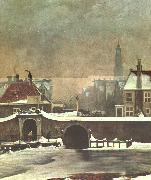 |
Wouter Johannes van Troostwijk -- Click Here
|
|
1782-1810
Dutch
Wouter Johannes van Troostwijk Gallery
Dutch painter, draughtsman and etcher. In 1803 he was admitted to the Amsterdam Tekenacademie where he was a pupil of the director, Jurriaan Andriessen. Despite a highly successful student career that culminated in a gold medal from the Felix Meritis Society in 1807, he was unable to establish himself as a professional artist during the remainder of his very short working life in Amsterdam. Andriessen's studies from nature seem to have been an important influence; van Troostwijk was one of the earliest artists to paint en plein air. Although he looked back to 17th-century Dutch landscape art and to the work of his contemporaries, in such paintings as Landscape in Gelderland (c. 1808; Amsterdam, Rijksmus.; see NETHERLANDS, THE, fig. 21) he achieved a totally new lyricism in the rendering of atmospheric effects. The Raampoortje (1809; Amsterdam, Rijksmus.) displays a fresh colouristic touch rare in Dutch painting of this period. His Self-portrait (c. 1810; Amsterdam, Rijksmus.) is equally original in composition and colour. He also produced animal paintings in the manner of Paulus Potter, drawings and a few etchings towards the end of his life. Van Troostwijk died before his considerable talents could be recognized, and, although he has come to be seen as an important precursor of much late 19th-century Dutch painting, he had little influence on his immediate successors. |
|
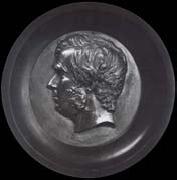 |
Woolner, Thomas -- Click Here
|
|
1825 - 1892,English sculptor and poet. He ranks with John Henry Foley as the leading sculptor of mid-Victorian England. He trained with William Behnes and in 1842 enrolled as a student at the Royal Academy, London. In 1844 he exhibited at Westminster Hall, London, a life-size plaster group, the Death of Boadicea (destr.), in an unsuccessful attempt to obtain sculptural commissions for the Houses of Parliament. His earliest important surviving work is the statuette of Puck (plaster, 1845-7; C. G. Woolner priv. col.), which was admired by William Holman Hunt and helped to secure Woolner's admission in 1848 to the Pre-Raphaelite Brotherhood. The work's Shakespearean theme and lifelike execution, stressing Puck's humorous malice rather than traditional ideal beauty, made it highly appealing. Although eclipsed by Hunt, John Everett Millais and Dante Gabriel Rossetti, Woolner was an important figure in the Brotherhood. He contributed poetry to its journal, The Germ (1850), and his work was committed to truthfulness to nature more consistently than that of any other Pre-Raphaelite, except for Hunt. This is evident in Woolner's monument to William Wordsworth (marble, 1851; St Oswald, Grasmere, Cumbria). |
|
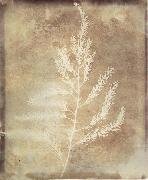 |
Willim Henry Fox Talbot -- Click Here
|
|
British, 1800-1877
|
|
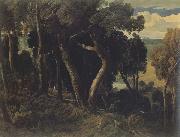 |
William Turner of Oxford -- Click Here
|
|
British, 1789-1862
He probably received his earliest training from William Delamotte, in Oxford. In 1804 he went to London and became a pupil of John Varley, possibly being formally apprenticed. He first exhibited at the Royal Academy in 1807; in January 1808 he was elected an associate of the Society of Painters in Water-Colours, and in November of that year became its youngest full member. He exhibited there annually from 1808 until his death, sending 455 works in all. His passionate, technically complex youthful work was highly acclaimed, yet its promise remained unfulfilled; around 1811 he returned to Oxfordshire and soon established himself as a drawing-master in Oxford. |
|
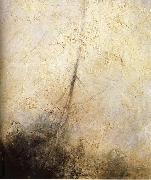 |
William Turner -- Click Here
|
|
English Romantic Painter, 1775-1851
British painter and printmaker. He dominated British landscape painting throughout the first half of the 19th century. He established a reputation in the Royal Academy, London, first as a topographical watercolourist and then within a few years as a painter of Sublime and historical landscapes. |
|
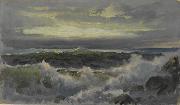 |
William Trost Richards -- Click Here
|
|
(June 3, 1833 - April 17, 1905) was an American landscape artist associated with both the Hudson River School and the American Pre-Raphaelite movement.
William Trost Richards was born on 3 June 1833 in Philadelphia. In 1846 and 1847 he attended the local Central High School. Between 1850 and 1855 he studied part-time with the German artist Paul Weber while working as designer and illustrator of ornamental metalwork. Richards first public showing was part of an exhibition in New Bedford, Massachusetts, organized by artist Albert Bierstadt in 1858. In 1862 he was elected honorary member of the National Academy of Design and Academician in 1871. In 1863, he became a member of the Association of the Advanced of Truth in Art, an American Pre-Raphaelite group. In 1866, he departed for Europe for one year. Upon his return and for the following six years he spent the summers on the East Coast. In the 1870s, he produced many acclaimed watercolor views of the White Mountains, several of which are now in the collection of the Metropolitan Museum of Art. Richards exhibited at the National Academy of Design from 1861 to 1899 and at the Brooklyn Art Association from 1863 to 1885. He was elected a full member of the National Academy in 1871.
Richards rejected the romanticized and stylized approach of other Hudson River painters and instead insisted on meticulous factual renderings. His views of the White Mountains are almost photographic in their realism. In later years, Richards painted almost exclusively marine watercolors.
His works are featured today in many important American museums, including the National Gallery, the Smithsonian American Art Museum, the Wadsworth Atheneum, the Philadelphia Museum of Art, the Yale University Art Gallery, the High Museum of Art, the Museum of Fine Arts, Boston, the Fogg Art Museum, the Brooklyn Museum of Art and the Thyssen-Bornemisza Museum.
|
|
|
|
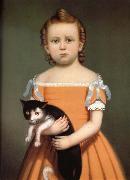 |
William Thompson Bartoll -- Click Here
|
|
American, 1817-1857 |
|
|
|
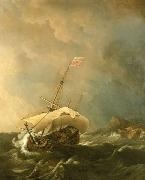 |
Willem Van de Velde The Younger -- Click Here
|
|
(bapt. 18 December 1633 - 6 April 1707) was a Dutch marine painter.
Willem van de Velde was baptised on 18 December 1633 in Leiden, Holland, Dutch Republic.
A son of Willem van de Velde the Elder, also a painter of sea-pieces, Willem van de Velde, the younger, was instructed by his father, and afterwards by Simon de Vlieger, a marine painter of repute at the time, and had achieved great celebrity by his art before he came to London. In 1673 he moved to England, where he was engaged by Charles II, at a salary of £100, to aid his father in "taking and making draughts of sea-fights", his part of the work being to reproduce in color the drawings of the elder van de Velde. He was also patronized by the Duke of York and by various members of the nobility.
He died on 6 April 1707 in London, England. |
|
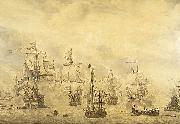 |
Willem van de Velde the Elder -- Click Here
|
|
(c. 1611 - 13 December 1693) was a Dutch Golden Age seascape painter.
Willem van de Velde, known as the Elder, a marine draughtsman and painter, was born in Leiden, the son of a Flemish skipper, Willem Willemsz. van de Velde, and is commonly said to have been bred to the sea. In 1706 Bainbrigg Buckeridge noted that he eunderstood navigation very welle. He married Judith Adriaensdochter van Leeuwen in Leiden, the Netherlands, in 1631.
His three known legitimate children were named Magdalena, born 1632; Willem, known as the Younger, also a marine painter, born 1633; and Adriaen, a landscape painter, born 1636.
His marriage was stormy, at least in its later years. David Cordingly relates that Willem the Elder fathered two children out of wedlock in 1653, one eby his maidservant, and the other by her friend. Nine years later the Elder and his wife went through a legal separation, eon account of legal disputes and the most violent quarrelse. The immediate cause of the dispute was his affair with a married woman.e Michael S. Robinson noted that eon 17/27 July 1662, he and his wife agreed to part. A condition of the separation was that the Elder could recover from his son Adriaen etwo royal giftse, presumably gifts from Charles II for work done in England.e Cordinglyes account further relates that the dispute was still continuing after another ten years, since ein the autumn of 1672 Judith complained to the womanes husband.e Robinson adds that by 1674 the couple emust have been reconcilede, for at a chance meeting with Pieter Blaeu in Amsterdam in July the Elder explained that he was only visiting for a few days ein order to fetch his wifee. His son, Adriaen, had died in Amsterdam in 1672, and Willem the Elder was also fetching his grandson, similarly named Adriaen, who was then aged two.
After his move to England, the exact date of which is uncertain, but reportedly at the end of 1672 or beginning of 1673, he is said to have lived with his family in East Lane, Greenwich, and to have used the Queenes House, now part of the National Maritime Museum in Greenwich, as a studio. Following the accession of William and Mary as King and Queen of England, it appears that this facility was no longer provided, and by 1691 he was living in Sackville Street, now close to Piccadilly Circus. He died in London, and was buried in St Jameses Church, at the south end of the street.
|
|
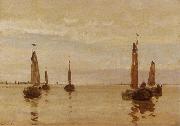 |
Willem Bastiaan Tholen -- Click Here
|
|
was a Dutch painter, draftsman and printmaker, born in Amsterdam, 13 Feb 1860, died in The Hague, 5 Dec 1931. He came from an artistic family, who lived in Kampen from 1864. There he developed at an early age a lasting love of the Zuiderzee. In Kampen he became friendly with the young Jan Voerman; they entered the Amsterdam academy together in 1876, where Tholen studied under August Allebe. Subsequently he learned technical drawing at the Polytechnische School in Delft until 1878. Thereafter he spent three months in the studio of Paul Gabriël in Brussels, from whom he received his first real instruction in painting. In the following years Gabriël's advice was of particular importance for Tholen, as they worked together en plein air for many summers near Kampen and Giethoorn, among other places. In Gouda (1878-9) and Kampen (1880-85) he taught draftsmanship in order to support himself but after 1885 concentrated entirely on his own work. From 1887 he lived in The Hague, where he became friendly with the painters of The Hague school. He took an active part in the artistic life of The Hague and was a member of the Pulchri Studio.
|
|
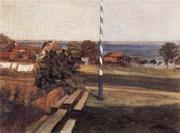 |
Wilhelm Trubner -- Click Here
|
|
German, 1851-1917
was a German realist painter of the circle of Wilhelm Leibl. Trubner was born in Heidelberg and had early training as a goldsmith. In 1867 he met classicist painter Anselm Feuerbach who encouraged him to study painting, and he began studies in Karlsruhe under Fedor Dietz. The next year saw him studying at the Kunstacademie in Munich, where he was to be greatly impressed by an international exhibition of paintings by Leibl and Gustave Courbet. Courbet visited Munich in 1869, not only exhibiting his work but demonstrating his alla prima method of working quickly from nature in public performances. This had an immediate impact on many of the city's young artists, who found Courbet's approach an invigorating alternative to the shopworn academic tradition. The early 1870s were a period of discovery for Tr??bner. He travelled to Italy, Holland and Belgium, and in Paris encountered the art of Manet, whose influence can be seen in the spontaneous yet restrained style of Trubner's portraits and landscapes. During this period he also made the acquaintance of Carl Schuch, Albert Lang and Hans Thoma, German painters who, like Trubner, greatly admired the unsentimental realism of Wilhelm Leibl. This group of artists came to be known as the "Leibl circle". He published writings on art theory in 1892 and 1898, which express above all the idea that "beauty must lie in the painting itself, not in the subject". By urging the viewer to discover beauty in a painting's formal values, its colors, proportions, and surface, Trubner advanced a philosophy of "art for art's sake". |
|
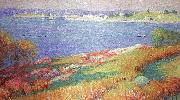 |
Wendel, Theodore -- Click Here
|
|
American, 1859-1932 |
|
|
|
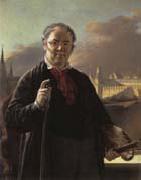 |
Vasily Tropinin -- Click Here
|
|
1776-1857
Russian painter. He was born a serf and in 1790 was apprenticed to a pastrycook in St Petersburg. From 1793 he attended classes at the Academy of Art there, in 1799 becoming a pupil of the portrait painter Stepan Shchukin (1762-1828). In 1804 he was sent to work as a pastrycook and manservant on an estate in the Ukraine owned by his master, General Morkov. Tropinin's Ukrainian period (1804-21) was interrupted by frequent, often protracted, visits to Moscow. During these years he copied a great deal, drew landscapes from nature and also painted religious subjects. His early style is painterly and distinguished by freedom of execution and skill in the use of colour, but the compositions are derivative and the drawing weak: The Spinner (1820s), The Lacemaker (1823), Wedding in the Village of Kukavka, Podolsky Province and Girl with a Bird (all Moscow, Tret'yakov Gal.). Portraiture, however, began to take on a more important place in his work; the best of this period is the Portrait of Arseny, the Artist's Son (1818; Moscow, Tret'yakov Gal.), especially notable for its use of colour. Tropinin captured perfectly the child's spontaneous vision of the world, his sensitive spirit and openness. While in Moscow from 1813 to 1818, he portrayed a series of important cultural figures that brought him great popularity. He was freed from serfdom on 8 May 1823 and shortly thereafter he became a nominee to the Academy for his paintings The Lacemaker |
|
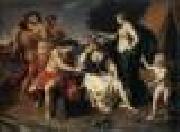 |
TURCHI, Alessandro -- Click Here
|
|
Italian Baroque Era Painter, 1578-1649
Italian painter. He first studied in Verona with Felice Brusasorci in whose studio he was recorded in 1597 (Brenzoni). Dal Pozzo reported that Turchi completed Brusasorci's Fall of the Manna (Verona, S Giorgio) after his master's death in 1605; his early Veronese paintings, such as the Adoration of the Shepherds (1608; Verona, S Fermo), are ambitious, with many figures and elaborate backgrounds, echoing the local tradition of which Paolo Veronese was the most distinguished exponent. Turchi may have gone to Venice with his fellow pupil, Marcantonio Bassetti, before moving to Rome c. 1614-15. He was paid for work in the Sala Regia of the Palazzo del Quirinale in 1616-17 (Briganti), where he collaborated with a team of artists, among them Giovanni Lanfranco and Carlo Saraceni. His part was to paint an oval medallion with the Gathering of the Manna (in situ) in a style that suggests Lanfranco's influence. He soon found patrons for altarpieces and cabinet paintings, among them Cardinal Scipione Borghese. By 1619 he had settled permanently in Rome and was a member of the Accademia di S Luca, |
|
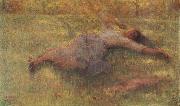 |
Tudor St George Tucker -- Click Here
|
|
1862 - 1906,was the son of Captain Charlton Nassau Tucker, a cavalry officer in the East India Company's service. He came to Melbourne in 1881. He studied at the national gallery school and afterwards at Paris. He returned to Melbourne and about the year 1893 was associated with E. Phillips Fox in the conduct of the Melbourne art school. He was back in London in 1899 working in a studio at Chelsea, and had two paintings in the 1900 Royal Academy exhibition, two in 1901 and one in 1902. He died in London in 1906. He suffered much from ill health and his work is comparatively little known. |
|
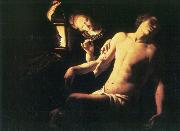 |
Trophime Bigot -- Click Here
|
|
Trophime Bigot (1579-1649/50), also known as Theophile Bigot, Teofili Trufemondi, Candlelight Master, Maître e la Chandelle, was a French painter of the Baroque era, active in Rome and his native Provence.
Bigot was born in Arles in 1579, where he began his artistic career. Between 1620 and 1634, Bigot was in Italy, including Rome. He is known to have been in Arles in 1634, where he painted the altarpiece Saint Laurent condamne au supplice (Saint Laurence Condemned to Torture) and Assomption de la Vierge (Assumption of the Virgin) for local churches.
Between 1638 and 1642, he lived in Aix-en-Provence, where he painted another Assumption of the Virgin. He returned to Arles in 1642, and divided his activities between this city and Avignon, where he died around 1650. |
|
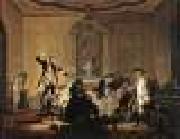 |
TROOST, Cornelis -- Click Here
|
|
Dutch painter (b. 1697, Amsterdam, d. 1750, Amsterdam).
Dutch painter, draughtsman and printmaker. He was the most important Dutch artist of the 18th century; he received many commissions (the catalogue by Niemeijer contains 925 numbers). Although he generally looked back to the genre scenes of the Dutch 17th-century masters, his satirical paintings earned him the nickname 'the Dutch Hogarth' after his English contemporary. |
|
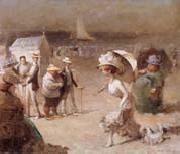 |
Trigoulet Eugene -- Click Here
|
|
French ,1867-Berck-sur-Mer 1910
|
|
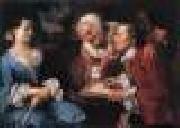 |
TRAVERSI, Gaspare -- Click Here
|
|
Italian Painter, ca.1722-1770
Italian painter. He was apprenticed to the elderly Francesco Solimena, whose late style, a reinterpretation of the Baroque art of Mattia Preti, influenced his earliest works. At the same time he studied the naturalist painters of the 17th century: Preti himself, Giovanni Battista Caracciolo, Jusepe de Ribera, Filippo Vitale and Francesco Fracanzano. Classical art also attracted him, and in the 1740s he began to make journeys to Rome to study the influential works of Bolognese and Roman classicism: paintings by Guido Reni, Guercino and the Carracci family, and by Carlo Maratti. During one of these visits he copied two pictures by Maratti, then in S Isidoro, Rome: the Flagellation and a Crucifixion . In the following year he was in Naples; three canvases of scenes from the Life of the Virgin (Naples, S Maria dell'Aiuto), one of which is signed and dated 1749 |
|
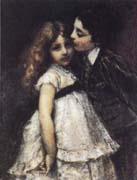 |
Tranquillo Cremona -- Click Here
|
|
Italian Painter , 1837-1878
Italian painter. The son of an Austrian government official, Cremona began his artistic education in 1849 at the art school in Pavia, where he encountered three Lombard artists who were an important influence on his early studies: Giacomo Tr?court (1812-82), head of the school; Giovanni Carnevali, Tr?court's friend and a frequent visitor to Pavia; and Federico Faruffini, also a student at Pavia. All three were interpreters of the curiously soft and subtle form of Romanticism, derived from Andrea Appiani, that was to be found in this specific form only in Italy. In 1852 Cremona moved to Venice, where he enrolled at the Accademia. His teachers, who included Ludovico Lipparini (1800-56), Michelangelo Grigoletti (1801-70) and Antonio Zona (1814-92), were well versed in the more academic form of Romanticism expressed by Francesco Hayez, although in Zona the rather rigid, academic linearity was attenuated by a softer sense of form and colour. The Venetian Old Masters were a greater influence on Cremona's ultimate use of colour than was his academy training. In 1859, to avoid military service with the Austrian Army, Cremona moved to Piedmont. |
|
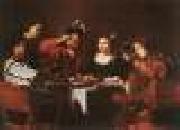 |
TOURNIER, Nicolas -- Click Here
|
|
French Baroque Era Painter, 1590-ca.1638 |
|
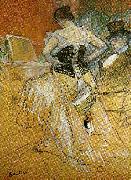 |
toulouse-lautrec -- Click Here
|
|
Fils d'Alphonse, comte Alphonse de Toulouse-Lautrec-Monfa (1838-1913) et d'Adele Tapie de Celeyran (1841-1930), il grandit entre Albi, le chateau du Bosc (demeure de ses grands-parents) et le chateau de Celeyran.
Henri de Toulouse-Lautrec est ne dans l'une des plus vieilles familles de France, descendant en effet en droite ligne des comtes de Toulouse, qui furent jusqu'au XIIIe si??cle parmi les plus puissants feodaux du royaume. Cependant, cette branche cadette, malgre son nom illustre, ne vit que comme une famille aisee de l'aristocratie de province. |
|
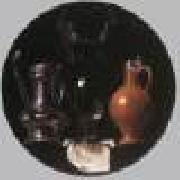 |
TORRENTIUS, Johannes -- Click Here
|
|
Dutch painter (b. 1589, Amsterdam, d. 1644, Amsterdam).
Dutch painter. He was active in Amsterdam, Leiden and Haarlem. In Haarlem in 1627 he was condemned, after severe torture, to 20 years of imprisonment for impiety, blasphemy and his membership of the outlawed Society of Rosicrucians. After having been notified by Sir Dudley Carleton, the British ambassador in The Hague, Charles I of England intervened and brought about Torrentius's release in 1629. Torrentius was subsequently active from 1629 to 1632 in London, which he nevertheless had to leave, again on account of his purportedly immoral mode of life; he returned to Amsterdam. There he was again involved in a trial and died after suffering torture in 1644. His erotic pictures, some of which depicted masterful nudes in mythological settings and are now known only through literary sources, were publicly burnt. A few still-lifes (e.g. Emblematic Still-life, 1614; Amsterdam, Rijksmus.) have survived. These carefully composed works, mostly set before a dark background, recall the work of Jan van de Velde II and the circle of Willem Claesz. Heda. |
|
 |
Tommaso Ruiz -- Click Here
|
|
Active in Naples during the second half of the 18th Century
|
|
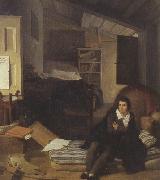 |
Tommaso Minardi -- Click Here
|
|
1787-1871
Italian painter, draughtsman, teacher and theorist. He studied drawing with the engraver Giuseppe Zauli (1763-1822) who imbued Minardi with his enthusiasm for 15th-century Italian art and introduced him to his large collection of engravings after the work of Flemish artists such as Adriaen van Ostade. However, Minardi was strongly influenced by the Neo-classical painter Felice Giani, who ran a large workshop in Faenza, and whose frescoes of mythological scenes (1804-5) at the Palazzo Milzetti he saw being painted. In 1803 he went to Rome on an annual stipend provided by Count Virgilio Cavina of Faenza (1731-1808), and he received (1803-8) additional financial assistance from the Congregazione di S Gregorio. He was given the use of Giani's studio and through him met Vincenzo Camuccini who, with Canova, dominated the artistic establishment in Rome at that time. Although Minardi learnt the precepts of Neo-classicism from Camuccini, he did not share his interest in heroic art. His first works done in Rome show his interest in the theme of master and acolyte. In Socrates and Alcibiades (1807; Faenza, Pin. Com.), for example, he has included himself among a group of elderly philosophers and young students who are placed on either side of a portrait bust of Zauli. He sent this drawing to his patrons, the Congregazione di S Gregorio, no doubt to reassure them of his aptitude and moral correctness. Supper at Emmaus (c. 1807; Faenza, Pin. Com.) was another painting destined for the same patrons. The confined pictorial space, with a single source of light entering through a small window, and the casual poses of the figures are reminiscent of Flemish art and of the works of the northern Caravaggisti, familiar to the artist through engravings. |
|
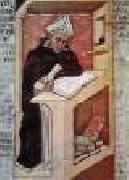 |
TOMMASO DA MODENA -- Click Here
|
|
Italian Painter, ca.1325-1379 |
|
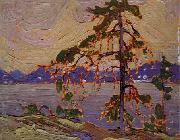 |
Tom Thomson -- Click Here
|
|
(August 5, 1877 - July 8, 1917), also known as Tom Thomson, was an influential Canadian artist of the early 20th century. He directly influenced a group of Canadian painters that would come to be known as the Group of Seven, and though he died before they formally formed, he is sometimes incorrectly credited as being a member of the group itself. Thomson died under mysterious circumstances, which added to his mystique.
|
|
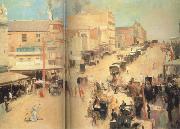 |
Tom roberts -- Click Here
|
|
British-born Australian Painter, 1856-1931
Australian painter of English birth. A leader of the HEIDELBERG SCHOOL and pioneer of plein-air Impressionism in Australia, he has been described as 'the father of Australian landscape painting'. Having moved to Melbourne in 1869, he studied at the East Collingwood and Carlton Schools of Design and the National Gallery of Victoria's School of Art (1874-81) while working as a photographic assistant. He led sketching expeditions with Frederick McCubbin and initiated student requests for reforms at the school. Returning to England, he enrolled in the Royal Academy Schools, London, on 6 December 1881, officially recommended by Edwin Long. In the summer of 1883 he toured Spain with the painter John Peter Russell. He learnt something of French Impressionism from Spanish art students Ramon Casas and Loreano Barrau (b 1864), and then followed the latter's advice to visit the Academie Julian in Paris. He returned to Melbourne in 1885 and the following year established the first summer camp at Box Hill with McCubbin and Louis Abrahams (1852-1903), portrayed in his painting the Artists' Camp (c. 1886; Melbourne, N.G. Victoria). According to the painter Arthur Streeton, it was Roberts's 'quick perception and expression of the principles of Impressionism in the year 1886, |
|
|
|
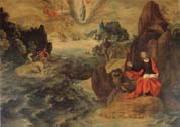 |
Tobias Verhaeght -- Click Here
|
|
1561-1631
was a painter and draughtsman active in Antwerp, Florence and Rome. Primarily a landscape painter, his style is indebted to mannerist world landscapes of artists like Joachim Patinir with high viewpoints, fantastic distant perspectives and three-colour scheme. Before Verhaecht entered Antwerp's guild of St. Luke in 1590?C91, he had already spent time in Italy, first in Florence, and then as a fresco painter in Rome. Peter Paul Rubens, who was a relative by marriage, studied with him around 1592, and another student was his own son, Willem van Haecht. |
|
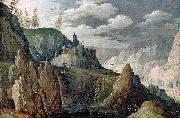 |
Tobias Verhaecht -- Click Here
|
|
(Antwerp, 1561 - 1631) was a painter and draughtsman active in Antwerp, Florence and Rome. Primarily a landscape painter, his style is indebted to mannerist world landscapes of artists like Joachim Patinir with high viewpoints, fantastic distant perspectives and three-colour scheme. Before Verhaecht entered Antwerp's guild of St. Luke in 1590-91, he had already spent time in Italy, first in Florence, and then as a fresco painter in Rome. Peter Paul Rubens, who was a relative by marriage, studied with him around 1592, and another student was his own son, Willem van Haecht. Verhaecht is also known for his designs for prints.
|
|
 |
Tobias Stimmer -- Click Here
|
|
(7 April 1539 - 4 January 1584) was a Swiss painter and illustrator. His most famous work is the paintings on the Strasbourg astronomical clock. He died in Strasbourg.
He was born in Schaffhausen, and was active in Schaffhausen, Strasbourg and Baden-Baden as a wall and portrait painter. He made a great number of drawings for woodcuts (Bible scenes, allegories, etc.) which were published by the printer Sigmund Feyerabend in Frankfurt am Main, and Bernhart Jobin in Strasbourg.
Stimmer followed Hans Holbein the Younger, but developed his own mannerism. Among his wall paintings remain the "House zum Ritter" in Schaffhausen, although this was actually much restored and changed.
|
|
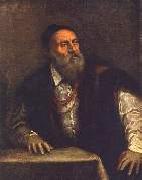 |
TIZIANO Vecellio -- Click Here
|
|
Italian painter, Venetian school (b. 1490, Pieve di Cadore, d.
1576, Venezia). |
|
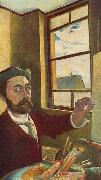 |
Tivadar Kosztka Csontvary -- Click Here
|
|
born 1853 - d. 1919) was a Hungarian painter. He was one of the first Hungarian painters to become well known in Europe.
Csontvery was born on 5 July 1853 in Kisszeben, Seros County, Kingdom of Hungary (today Sabinov, Slovakia), and died 20 June 1919 in Budapest. His ancestors were Poles who settled down in Hungary. Although Csontvery was obsessed with his Magyar roots, he himself grew up speaking Slovak mixed with German. He was a pharmacist until his twenties. On a hot sunny afternoon, 13 October 1880, e when he was 27 years old e he experienced a mystic vision. He heard a voice saying "you will be the greatest sunway painter, greater than Raphael!" He took journeys around Europe, visited the galleries of the Vatican, then went home to collect money for his journeys working as an apothecary. From 1890 onwards he traveled around the world. He visited Paris, the Mediterraneum (Dalmatia, Italy, Greece), North Africa and the Middle East (Lebanon, Palestine, Egypt, Syria) and painted pictures. He painted his major works between 1903 and 1909. He had some exhibitions in Paris (1907) and Western Europe. Most of the critics in Western Europe recognized his abilities, art and congeniality, but in the Kingdom of Hungary during his life he was considered to be an eccentric crank for several reasons, e. g. for his vegetarianism, anti-alcoholism, anti-nicotinism, pacifism, his latent, but more and more apparent schizophrenia and his cloudy, prophetic writings and pamphlets about his life (Curriculum), genius (The Authority, The Genius) and religious philosophy (The Positivum). Even though later he was acclaimed, during his lifetime Csontvery's visionary, expressionistic style found little understanding. A loner by nature, the master's mental balance was upset by his efailuree impairing his creative power. Little did he know that some years after his death, an entire museum in Paris, Hungary, would be devoted to his paintings, and that worldwide appreciation of his works would be in constant ascendancy. Many painters, e.g. Picasso added a stone to Csontvery's cairn.
|
|
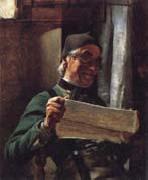 |
Tito Lessi -- Click Here
|
|
Italian artist, 1858-1917 |
|
|
|
 |
Titian -- Click Here
|
|
Italian High Renaissance Painter, ca.1485-1576
Italian painter active in Venice. As a young man he was taught by the Bellini family and worked closely with Giorgione. His early works are so similar in style to Giorgione's as to be indistinguishable, but soon after Giorgione's early death Titian established himself as the leading painter of the Republic of Venice. Among his most important religious paintings is the revolutionary and monumental Assumption (1516 ?C 18) for Santa Maria dei Frari, in which the Virgin ascends to heaven in a blaze of colour accompanied by a semicircle of angels. Titian was also interested in mythological themes, and his many depictions of Venus display his work's sheer beauty and inherent eroticism. Bacchus and Ariadne (1520 ?C 23), with its pagan abandon, is one of the greatest works of Renaissance art. Titian was sought after for his psychologically penetrating portraits, which include portrayals of leading Italian aristocrats, religious figures, and Emperor Charles V. He reached the height of his powers in The Rape of Europa (c. 1559 ?C 62), one of several paintings done for Philip II of Spain. He was recognized as supremely gifted in his lifetime, and his reputation has never declined. |
|
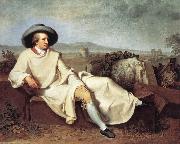 |
TISCHBEIN, Johann Heinrich Wilhelm -- Click Here
|
|
German Painter, 1751-1829 |
|
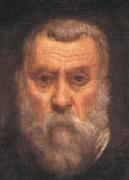 |
TINTORETTO, Jacopo -- Click Here
|
|
Birth Year:, 1518. Death Year:, 1594 |
|
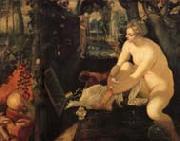 |
Tintoretto -- Click Here
|
|
Italian Mannerist Painter, ca.1518-1594
His father was a silk dyer (tintore); hence the nickname Tintoretto ("Little Dyer"). His early influences include Michelangelo and Titian. In Christ and the Adulteress (c. 1545) figures are set in vast spaces in fanciful perspectives, in distinctly Mannerist style. In 1548 he became the centre of attention of artists and literary men in Venice with his St. Mark Freeing the Slave, so rich in structural elements of post-Michelangelo Roman art that it is surprising to learn that he had never visited Rome. By 1555 he was a famous and sought-after painter, with a style marked by quickness of execution, great vivacity of colour, a predilection for variegated perspective, and a dynamic conception of space. In his most important undertaking, the decoration of Venice's Scuola Grande di San Rocco (1564 C 88), he exhibited his passionate style and profound religious faith. His technique and vision were wholly personal and constantly evolving. |
|
|
|
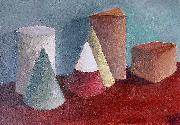 |
Tim Verfaillie -- Click Here
|
|
(Brugge, 14 January 1893 - Rochefort, 1934) was Belgian painter who was one of the smaller figures of Flemish expressionism.
In his younger days he travelled through the Scottish Highlands. The atmosphere he witnessed there would remain an important influence in his work.
|
|
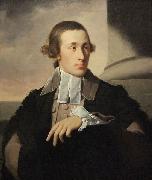 |
Tilly Kettle -- Click Here
|
|
(1735-1786) was a portrait painter and the first English painter to work in India. He was born in London, the son of a coach painter, in a family that had been members of the Brewers' Company of freemen for five generations. He studied drawing with William Shipley in the Strand and first entered professional portraiture in the 1750s.
Kettle's first series of portraits appeared in the 1760s. His first surviving painting is a self-portrait from 1760, with his first exhibit at the Society of Artists in 1761. In 1762, he worked at restoring Robert Streater's ceiling fresco in the Sheldonian Theatre, Oxford, and painted Francis Yarborough, a doctor of Brasenose College, Oxford in 1763. He painted many members of the family of William Legge, 2nd Earl of Dartmouth. In 1764-5, he was active in London and continued exhibiting at the Society of Artists.
In 1768, Kettle sailed to India with the British East India Company, landing at Madras (now Chennai), where he remained for two years. There, he painted Lord Pigot and Muhammad Ali Kahn twice (once alone and once with five of his sons). He also painted non-portraits, including Dancing Girls (Blacks) in 1772 and a suttee scene in 1776 entitled, The ceremony of a gentoo woman taking leave of her relations and distributing her jewels prior to ascending the funeral pyre of her deceased husband. In 1770 Kettle painted a half-length portrait of 'Sir' Levett Hanson, a peripatetic writer on European knighthood and chivalry originally from Yorkshire. (The portrait is now in the collection of the Bury St Edmunds Manor House Museum.)
Kettle moved on to Calcutta (now Kolkata) in 1771 and painted Shuja ud-Daula and Dancing-Girl Holding the Stem of a Hookah. In 1775,he painted George Bogle, Warren Hastings' emissary to Tibet, in Tibetan dress, presenting a ceremonial white scarf to Lobsang Yeshe the 5th Panchen Lama.He also took an Indian mistress and had two daughters by her. |
|
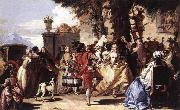 |
TIEPOLO, Giovanni Domenico -- Click Here
|
|
Italian painter, Venetian school (b. 1727, Venezia, d.
1804, Venezia).
Italian painter and printmaker. He was apprenticed to his father, Giovanni Battista Tiepolo, in Venice in the early 1740s and worked with him in Madrid from 1762 until the elder's death in 1770. His most notable early works are the chinoiserie decorations of the Villa Valmarana in Vicenza (1757). Back in Venice, he executed several frescoes and paintings of scenes from the commedia dell'arte. A talented genre painter and caricaturist, he was famous for his many engravings and etchings after his own and his father's designs.
|
|
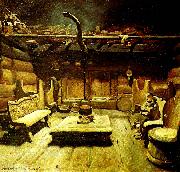 |
tidemand -- Click Here
|
|
Tidemand kom vid 17 års ålder till Köpenhamns konstakademi, studerade där i fem år, tänkte sedan utbilda sig till historiemålare i Munchen, men valde i stället på en kamrats råd Dusseldorf till studieort och reste dit 1837. Han blev elev av Theodor Hildebrandt, men tog tidigare intryck av Carl Friedrich Lessings relativt realistiska historiemåleri. Hans första större målning behandlade ett svenskt ämne, Gustaf Vasa talar till dalkarlarna vid Mora (1841). Målningen inköptes av Rhens och Westfalens konstförening samt förskaffade Tidemand ett resestipendium från Norge och beställning på en altartavla till Vor Freisers kirke i Kristiania.
Han reste sedan till Munchen och Italien, återvände till Norge på ett kort besök sommaren 1842, gjorde en studieresa i fjälltrakterna för att samla material till en påtänkt fosterländsk historiemålning, men kom nu till klarhet över sitt mål. Han ville, som han själv yttrat, skildra detta kraftiga naturfolks karaktär seder och vanor. Hans första tavla i detta syfte var Sagoberätterskan 1844, inköptes av drottning Josefina och förskaffade konstnären medlemskap av svenska konstakademien. Efter nya studieresor i Norge målade han Söndagskväll i Hardanger köptes av Oscar I, på slottet i Kristiania och Gudstjänst i en landskyrka. Han bosatte sig 1845 på allvar i Dusseldorf och vann snart ett namn genom de norska bondelivsbilderna. Samma år målade Tidemand i samarbete med Hans Fredrik Gude den romantiska Brudefärden i Hardanger.
Revolutionsoroligheterna hade vid denna tid drivit de norske konstnärerna hem till Norge, och det såg ut, som skulle konsten nu bli rotfäst i hemlandet. Impulsen till en nationell konst gavs, men då lugn åter inträdde, återvände konstnärerna till utlandet. Under de närmaste åren målade Tidemand för det av Oscar I uppförda lilla lustslottet Oskarshal, som pryddes av uteslutande norska konstverk, serien Norskt bondeliv. Hans sista arbete var förstudier till en aldrig utförd historiemålning, Kristian IV grundlägger Kristiania, beställd av Oscar II. Tidemand skapade även tre altartavlor. I samarbete med Gude målade han Afton på Kröderen (1849), Ljustring (1850), Likfärd på Sognefjorden (1853), Fiskare i fara (1859), med Sophus Jacobsen Lappar på renjakt (1873) och med Morten M??ller Sinclairs landstigning i Romsdalen (1875).
Han blev av sin samtid hyllad som Norges främsta representativa konstnär. Hans betydelse ligger i att han i sin konst gav uttryck åt det nationella uppvaknandet i sitt hemland. På samma gång föreställde han det norska folket för den stora allmänheten i utlandet. I Tyskland betraktades han som en av de främsta representanter i samtidens konst. Han fick många utmärkelser såväl i Tyskland som i Paris och i England, och hans arbeten såldes till höga pris. Sina mest omtyckta målningar upprepade han med tillhjälp av flera medhjälpare gång på gång, några i ända till 12 exemplar. Många av hans arbeten är återgivna i kopparstick och litografi. L. Dietrichson utgav Adolph Tidemand, hans liv og hans værker (2 delar, 1878-79). |
|
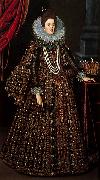 |
Tiberio Titi -- Click Here
|
|
Italy (1573 -1627 ) - Painter |
|
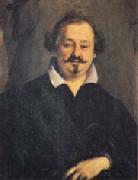 |
Tiberio Tinelli -- Click Here
|
|
Italian Baroque Era Painter, 1586-1638
was an Italian painter of the early-Baroque period, active mainly in his native city of Venice. He trained with Giovanni Contarini, a pupil of the late Titian. Tinelli then either worked under or emulated Leandro Bassano. He was well known for his portraits of aristocracy, merchants, and intellectuals in Venice, whom he often painted in historical dress. His small pictures of historical and mythological subjects were also popular. Some of his pictures found their way into the collection of Louis XIII, king of France, who knighted him with the order of Michael. He moved later in life in Florence. |
|
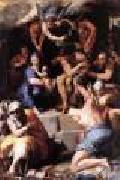 |
TIBALDI, Pellegrino -- Click Here
|
|
Italian Painter, 1527-1596
Painter and architect. Pellegrino Tibaldi's early paintings show the influence of Bagnacavallo and of other Bolognese followers of Raphael, but his actual teacher is unknown. Vasari's claim that his own works in S Michele in Bosco, Bologna, formed Tibaldi's artistic education is hardly borne out by the latter's first efforts. The Mystic Marriage of St Catherine (c. 1545; Bologna, Pin. N.) is, in its classical, hierarchical simplicity, clearly inspired by Raphael's manner as interpreted by his Bolognese imitators; although it also bears delicate marks of Parmigianino's grace, the power of its expressive dignity and the architectural background hint at Tibaldi's future development. Tibaldi's Adoration of the Shepherds |
|
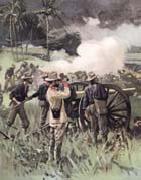 |
Thure de Thulstrup -- Click Here
|
|
Famous for paintings of American colonial life.
American , 1848-1930
|
|
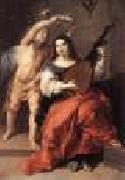 |
THULDEN, Theodor van -- Click Here
|
|
Flemish Baroque Era Painter, 1606-1669 |
|
 |
threshing wheat -- Click Here
|
|
early sixteenth century.
paris. muse'e des arts de'coratifs |
|
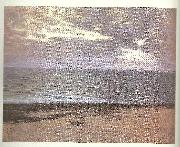 |
thorvald niss -- Click Here
|
|
Født i Assens 07.05.1842, død Frederiksberg 11.05.1905, maler
Det Kgl. Danske Kunstakademi 1861-1869, afbrudt af frivillig deltagelse i krigen 1864.
Otto Baches atelier i 1870'erne |
|
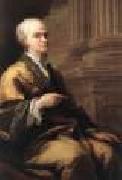 |
THORNHILL, Sir James -- Click Here
|
|
English painter (b. 1676, Melcombe Regis, d. 1734, Weymouth).
|
|
|
|
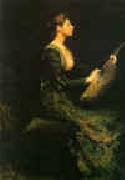 |
Thomas Wilmer Dewing -- Click Here
|
|
1851-1938
Thomas Wilmer Dewing Gallery
was an American painter working at the turn of the 20th century. He was born in Newton Lower Falls, Massachusetts. He studied at the Acad??mie Julian in Paris, and later settled into a studio in New York City. He married Maria Oakey Dewing, an accomplished painter with extensive formal art training and familial links with the art world.
He is best known for his tonalist paintings, a sub-genre of American art that was rooted in English Aestheticism. Dewing's preferred vehicle of artistic expression is the female figure. Often seated playing instruments, writing letters, or engaged in other impassive actions and situated in gauzy, dreamy interiors, the figures remain remote and distant to the viewer. These scenes are infused with a color that pervades the entire picture, setting tone and mood. The ethereal delicacy and subtle color harmonies of Dewing's paintings have not met with universal approval: some feminist critics have lambasted Dewing's work as being misogynistic; he rarely painted anything other than the female figure, vacant of expression, languishing in sumptuous clothing.
Tonalism quickly came to be considered outdated with the advent of modernism and abstraction in art, though Dewing was successful in his own day. His art was considered extremely elegant, and has undergone a subtle revival in the last 10 years or so.
Dewing was a member of the Ten American Painters, a group of American Impressionists who seceded from the Society of American Artists in 1897.
He spent his summers at the art colony in Cornish, New Hampshire. |
|
|
|
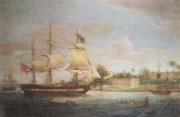 |
Thomas Whitcombe -- Click Here
|
|
British
1760-1824
British 1760-1824 was a British maritime painter Thomas Whitcombe was born in London between 1752 and 19 May 1763, with the latter date frequently cited. Little is known of his background or training, although speculation based on the locations depicted in his paintings may provide some clues. It is known that he was in Bristol in 1787 and later travelled to the South Coast; there are few ports or harbours from this region that do not feature in his work. In 1789 he toured Wales and in 1813 he travelled to Devon, painting scenes around Plymouth harbour. During his career he also painted scenes showing the Cape of Good Hope, Madeira, Cuba and Cape Horn. Between 1783 and 1824 he lived in London. His date of death, like that of his birth is uncertain; it was not before 1824, and possibly as late as 1834. |
|
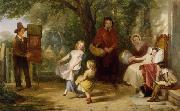 |
Thomas Webster -- Click Here
|
|
(March 10, 1800 - September 23, 1886), was an English genre painter, who lived for many years at the artists' colony in Cranbrook.
Webster was born in Ranelagh Street, Pimlico, London. His father was a member of the household of George III, and the son, having shown an aptitude for music, became a chorister, first at St George's Chapel in Windsor Castle, then the Chapel Royal at St. James's Palace in London. He abandoned music for painting, however, and in 1821 was admitted as a student to the Royal Academy, exhibiting, in 1824, portraits of "Mrs Robinson and Family." In the following year he won first prize in the school of painting.
In Sickness and Health (1843)In 1825, also, Webster exhibited 'Rebels shooting a Prisoner,' at the Suffolk Street Gallery - the first of a series of pictures of schoolboy life for which he subsequently became known - . In 1828 he exhibited 'The gunpowder Plot' at the Royal Academy, and in 1829 'The Prisoner' and 'A Foraging Party aroused' at the British Institution. These were followed by numerous other pictures of school and village life at both galleries. In 1840 Webster was elected an associate of the Royal Academy (ARA), and in 1846 a Royal Academician (RA) academician. He continued to be a frequent exhibitor till 1876, when he retired from the academy. He exhibited his own portrait in 1878, and 'Released from School,' his last picture, in 1879.
In 1856 Webster was photographed at 'The Photographic Institute', London, by Robert Howlett, as part of a series of portraits of 'fine artists'. The picture was among a group exhibited at the Art Treasures Exhibition in Manchester in 1857.
From 1835 to 1856 Webster resided at The Mall, Kensington, but the last thirty years of his life were spent at the artists' colony in Cranbrook, Kent, where he died on 23 Sept. 1886.
|
|
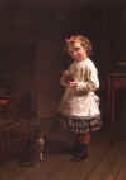 |
Thomas Waterman Wood -- Click Here
|
|
1823-1903
It may be that his reputation as an artist will rest upon his figure pictures, although his very numerous portrait paintings involved much of the effort of his life and are most certainly characterized but simple and strong composition, great technical execution and a masterful use of colors. It may also follow that he will yet achieve his most memorable honors from the interpretations which he has made of great paintings, but from the stand point of those whose minds and hearts are won by considerations of local history the highest interest will be assigned to works in which Wood included characters from his native place. As examples of his work in this direction the following may be mentioned: The Yankee Pedlar had for its model a tin peddler known as "Snapping Tucker", a resident of Calais, Vermont. When this work was sold for a large sum, Tucker promptly claimed his share upon the grounds of his intrinsic worth and natural capacity as a poser. The Village Post Office was taken from the interior of the old Ainsworth store in Williamstown, Vermont, but the figures were mostly taken from Montpelier people. Wood's uncle Zenas was the postmaster and the group around the store, Boyden, Whittier and Bullock, were old-time residents. Their clerk was Horace Scribner, long esteemed as a generous country musician and as the organist of Christ Church. This painting was bought by Mr. Charles Stewart Smith, ex-president of the New York Chamber of Commerce. The scene for the The Quack Doctor was located in front of the old arch which once spanned the head of State Street leading to East State. The old brick building, the home of Montpelier Book Bindery, still stands. This picture was bought by Mr. George I. Seneg for $2,000 and after his death was included in the sale of his entire collection.
Another successful painting was The Country Doctor. The artist found the proper model for this work with the aid of the Secretary of State, Dr. George Nichols, in the person of an actual country doctor, then representing the town of Jamaica in the legislature. This doctor bore upon his face the impress of his beneficent labors for more than 40 years in a back country town. Wood himself told the writer, in speaking of this painting, that many a person had said to him, "That doctor is the exact image of my father, who was also a country doctor." This saying he regarded not so much as proof that he had achieved a concrete likeness but as an evidence of having successfully handed down the particular class idea of the old-fashioned country physician, as truly different in type from the city practitioner as was the country lawyer of former days from his brother in the city.
In 1891, Wood exhibited at the Academy a picture entitled A Cogitation, for which one of his Montpelier friends, Mr. George Ripley, posed. The composition is extremely simple, a farmer in his barn, leaning upon his pitchfork, his countenance thoughtful. This picture was bought by Mr. Harper and published as a full-page engraving in Harper's Weekly during the Greeley campaign over the title "Is Greeley a Fool or a Knave?". The humorous side of this incident consists in the fact that Mr. Ripley was the model was an ardent supporter of Mr. Greeley in that campaign, while the artist himself, so far as we know, never dabbled in politics.
These few examples sufficiently illustrate the influence which the place of his birth had upon Wood. He was not only a Vermonter but a great painter of Vermont ideas, conditions and character. Nor did foreign travel nor city residence nor any influence of professional connections ever tend to diminish the deep and abiding interest in his early home. The subjects of his works, his selection of characters, his yearly pilgrimage to Vermont, all demonstrate his filial loyalty and he gave to this sentiment of his heart its final expression in the establishment, as a gift to Montpelier, of its Gallery of Art. But, apart from this, the homes, offices and institutions of Montpelier and without are filled with the affectionate and great evidences of his work. The Vermont Historical Society possesses several excellent examples of his portraiture, all of great historic value and preserved in the Cedar Creek Reception Room at the Vermont State House: Samuel Prentiss (1881), United States Senator; Mrs. Samuel Prentiss (1895) and Dr. Edward Lamb (1895), gifts to the Society by the family of Mr. Prentiss. In 1896, the Society unveiled a life-size portrait of the distinguished publicist, the Hon. E. P. Walton, the gift of his wife and sister. Wood's personal donations include portraits of the Rev. William A. Lord, D.D. (1874), minister of Bethany Congregational Church of this city, Daniel Pierce Thompson (1880), novelist and author of "The Green Mountain Boys", and Justin S. Morrill, United States Senator, father of tariff legislation, promoter of agricultural colleges and chief up builder of the Library of Congress.
One of the noblest paintings now existing in the state is the artist's beautiful translation of Bartolom?? Esteban Murillo's "La Madonna del Rosario". This work, submitting the original with infinite tenderness and feeling, was painted in 1896 in the Dulwich Gallery and was consecrated by Bishop de Goesbriand for the service of Saint Augustine's Church on July 26, 1897. The essential force of this sacred painting is its actual power to impress the beholder with a profound sense of the sacredness of motherhood and the worth and lasting values of purity and religious faith. In accepting this donation from Wood the Reverend Bishop said: "You have made a great Murillo of the seventeenth century our contemporary," an expression not only true of itself but one which defines the special value of the truly great copies of great paintings. |
|
|
|
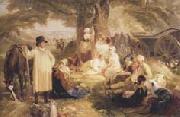 |
Thomas Uwins -- Click Here
|
|
English Painter, 1782-1857
English painter and illustrator. He was apprenticed to the line-engraver Benjamin Smith (d 1833) in 1797, but his greater interest in portrait painting led him to take life classes at the Royal Academy, London; he exhibited portraits there from 1799. Versatile and industrious, he painted miniature likenesses, taught drawing, designed and engraved illustrations for books in French, Portuguese and English, and wrote for and illustrated Rudolph Ackermann's Repository. His half-a-crown watercolours, known as 'pretty faces', were particularly popular, and he found employment as an assiduous copyist. In 1809 he was elected to the Society of Painters in Water-Colours and for the next nine years exhibited careful and colourful images of the countryside that provided views of the year's harvest. In 1817 Uwins travelled to France to record the Burgundian grape harvest, identifying the labour force more obviously as peasants than their English counterparts. In debt, he moved in 1820 to Edinburgh, where he illustrated books by Walter Scott and painted portraits. In 1824, his debt paid, he left for Italy, where he spent seven years; he sent highly valued copies of Italian works back to England (to Thomas Lawrence among others) and made studies of life in and around Rome and Naples, from which his later successes at the Royal Academy derived. An immodest Protestant, Uwins deplored but revelled in the 'polluted streams' of Catholic Italy, and provided London with oils renowned for their clarity and colour. A Neapolitan Saint Manufactory (exh. RA 1832; Leicester, Mus. & A.G.) shows monks haggling, women gazing and children playing amid carved and painted icons. |
|
|
|
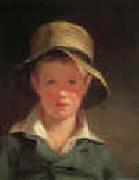 |
Thomas Sully -- Click Here
|
|
1783-1872
Thomas Sully Galleries
Sully became a professional painter at age 18 in 1801. He studied face-painting under Gilbert Stuart in Boston for three weeks. After some time in Virginia with this brother, Sully moved to New York, after which he moved to Philadelphia in 1806, where he resided for the remainder of his life. In 1809 he traveled to London for nine months of study under Benjamin West.
Sully's 1824 portraits of John Quincy Adams, who became President within the year, and then the Marquis de Lafayette appear to have brought him to the forefront of his day. (His Adams portrait may be seen in the National Gallery of Art, Washington.) Many famous Americans of the day had their portraits painted by him. In 1837-1838 he was in London to paint Queen Victoria at the request of Philadelphia's St. George's Society. His daughter Blanche assisted him as the Queen's "stand-in", modeling the Queen's costume when she was not available. One of Sully's portraits of Thomas Jefferson is owned by the Jefferson Literary and Debating Society at the University of Virginia and hangs in that school's Rotunda. Another Jefferson portrait, this one head-to-toe, hangs at West Point, as is his portrait of Alexander Macomb (American general).
Sully's own index indicates that he produced 2631 paintings from 1801, most of which are currently in the United States. His style resembles that of Thomas Lawrence. Though best known as a portrait painter, Sully also made historical pieces and landscapes. An example of the former is the 1819 Passage of the Delaware, now on display at the Museum of Fine Arts, Boston. |
|
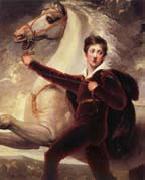 |
Thomas Stothard -- Click Here
|
|
English Neoclassical Painter, 1755-1834,English illustrator, painter and designer. He was one of the most popular, prolific and successful artists of his time and was highly regarded by such contemporaries as Thomas Lawrence and Walter Scott. He was the son of a prosperous publican and completed his apprenticeship as a silk weaver (1770-77), before studying at the Royal Academy, London (1777-c. 1783). From the beginning of his career, book illustration was his main area of activity. His earliest surviving works are in the decorative Rococo mode, but he soon adopted the more idealistic Neo-classicism of John Hamilton Mortimer and James Barry. Together with his friends and near contemporaries, William Blake and John Flaxman, Stothard developed an austere, linear style of draughtsmanship. |
|
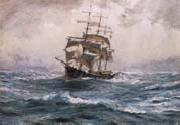 |
Thomas Somerscales -- Click Here
|
|
English painter, 1842-1927 |
|
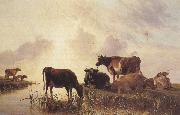 |
Thomas sidney cooper,R.A. -- Click Here
|
|
1803-1902
English painter. He was encouraged in his ambition to become an artist by Sir Thomas Lawrence and the animal painter Abraham Cooper (no relation; 1787-1868). He entered the Royal Academy Schools, London, in 1823. He subsequently taught art in Brussels where he met Eugene Verboeckhoven, whose work had a profound influence on him. Through Verboeckhoven he came to appreciate the work of such 17th-century Dutch painters as Aelbert Cuyp and Paulus Potter. In 1831 he returned to London, exhibiting at the Royal Society of British Artists. He exhibited 48 pictures at the British Institution between 1833 and 1863. The majority of his work was, however, exhibited at the Royal Academy; from 1833 to 1902 he exhibited 266 works there without a break, |
|
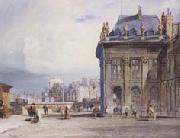 |
Thomas Shotter Boys -- Click Here
|
|
English Engraver, 1803-1874
English painter and printmaker. He was apprenticed on 4 February 1817 to George Cooke. His early training in engraving influenced his future career; his ability to draw a fine line, lay aquatint washes and hand-colour prints was an important factor in the creation of his particularly lucid style of watercolour landscapes and townscapes. At this time Cooke was engraving volumes of picturesque views by Turner and James Hakewell (1778-1843) as well as his own view of the Thames (1822); |
|
|
|
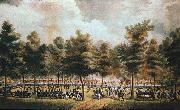 |
Thomas Ruckle -- Click Here
|
|
was a house painter and sign painter in early nineteenth century Baltimore, Maryland, and an amateur painter. He is best known for his paintings The Battle of North Point, and The Defense of Baltimore. Ruckle was a veteran of the War of 1812, in which he had served as a corporal in the 5th Maryland Regiment of the Maryland Militia.
Ruckle was born in Ireland and, having moved to Baltimore, Maryland, he became a sign painter and house painter. It is likely that he had very little, if any, formal training as an artist. |
|
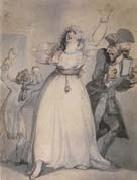 |
Thomas Rowlandson -- Click Here
|
|
English Illustrator, 1756-1827,English caricaturist, watercolourist, draughtsman and engraver. Although he is commonly thought of as a satirist, most of his drawings are gently humorous, and in some cases objective, records of urban and rustic life. With the exception of a small number of topographical drawings, they are characterized by an abundance of picaresque incidents, whether robust or sentimental, and have much in common with the novels of Laurence Sterne and Henry Fielding, which Rowlandson illustrated in 1808 and 1809. |
|
|
|
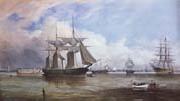 |
Thomas Robertson -- Click Here
|
|
January 9, 1829 ?C February 3, 1871,English dramatist and actor; brother of Madge Kendal. After spending several years as an actor, he turned to playwriting, initiating the ecup and saucere school of drama, which was characterized by its realism and its contemporary, domestic setting. His first successful play, David Garrick (1864), was followed by Society (1865) and Ours (1866). With Caste (1867) he began a close association with Squire Bancroft and his wife, Marie Wilton Bancroft, the actress, and they produced several of his plays. |
|
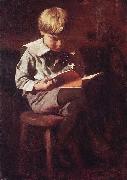 |
Thomas Pollock Anshutz -- Click Here
|
|
(1851-1912) was an American painter and teacher.
He studied art at the National Academy of Design in New York City, and moved to Philadelphia in 1875 to study under Thomas Eakins at the Philadelphia Sketch Club. He entered the Pennsylvania Academy of the Fine Arts in 1876, becoming Eakins's assistant there in 1878, and his successor in 1886. He later studied in Paris at the Academie Julian, 1892-93 |
|
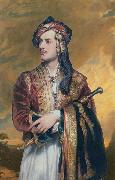 |
Thomas Phillips -- Click Here
|
|
(18 October 1770 - 20 April 1845) was a leading English portrait and subject painter. He painted many of the great men of the day including scientists, artists, writers, poets and explorers.
Phillips was born at Dudley then in Worcestershire. Having acquired the art of glass-painting in Birmingham under Francis Eginton,[1] he visited London in 1790 with an introduction to Benjamin West, who found him employment on the painted-glass windows of St George's Chapel at Windsor. In 1791, he became a student of the Royal Academy, and exhibited there, in 1792, a view of Windsor Castle, followed in the next two years by the "Death of Talbot, Earl of Shrewsbury, at the Battle of Castillon," "Ruth and Naomi," "Elijah restoring the Widow's Son," "Cupid disarmed by Euphrosyne," and other pictures.
After 1796, he mainly confined himself to portrait-painting. However, the field was very crowded with the likes of John Hoppner, William Owen, Thomas Lawrence and Martin Archer Shee competing for business; consequently, from 1796 to 1800, his exhibited works were chiefly portraits of gentlemen and ladies, often nameless in the catalogue and of no great importance historically-speaking.
|
|
 |
Thomas Patch -- Click Here
|
|
1725 - 1782
was an English painter, engraver and caricaturist. He made a living by basing himself in Italy and undertaking commissions from rich young British men on Grand tours.His paintings today are in the Royal Collection and various museums. Patch was thrown out of Rome for a homosexual act. Patch was born in Exeter in 1725, the son of a doctor. He had not completed his medical studies when he came to Rome in 1747 as a grand tourist and where he met Joshua Reynolds. Initially he worked for Joseph Vernet, creating landscapes of Tivoli and pastiches of Vernet's work. He was forced to leave Rome after some homosexual He was in Florence in 1755, where he was commissioned to paint people on their Grand tours. Here he was assisted by his friendship with Sir Horace Mann, who was the British envoy and therefore a point of contact with British tourists arriving in Florence. While there he completed studies of human physiognomy, looking at the expressions and facial types as well as completing portraits of many in the British society in Florence. He also studied the old masters and published studies of them. Towards the end of his life his output of paintings slowed.Patch was also known to be an art dealer. In about 1763, Patch completed three views of Florence that are now part of the Royal Collection. They are thought to have been bought by George III. On October 19, 1767, he was enterprising enough to witness the eruptions of Mount Vesuvius which he painted from both the land and the sea. |
|
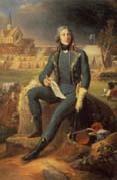 |
Thomas Pakenham -- Click Here
|
|
19 October 1864?C21 August 1915 |
|
|
|
|
| | |
|
|
|
|